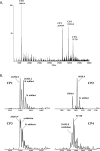A case for "StopGo": reprogramming translation to augment codon meaning of GGN by promoting unconventional termination (Stop) after addition of glycine and then allowing continued translation (Go)
- PMID: 17456564
- PMCID: PMC1869043
- DOI: 10.1261/rna.487907
A case for "StopGo": reprogramming translation to augment codon meaning of GGN by promoting unconventional termination (Stop) after addition of glycine and then allowing continued translation (Go)
Abstract
When a eukaryotic mRNA sequence specifying an amino acid motif known as 2A is directly followed by a proline codon, two nonoverlapping proteins are synthesized. From earlier work, the second protein is known to start with this proline codon and is not created by proteolysis. Here we identify the C-terminal amino acid of an upstream 2A-encoded product from Perina nuda picorna-like virus that is glycine specified by the last codon of the 2A-encoding sequence. This is an example of recoding where 2A promotes unconventional termination after decoding of the glycine codon and continued translation beginning with the 3' adjacent proline codon.
Figures



References
-
- Atkins, J.F., Gesteland, R.F. A case for trans translation. Nature. 1996;379:769–771. - PubMed
-
- Baranov, P.V., Gesteland, R.F., Atkins, J.F. Recoding: Translational bifurcations in gene expression. Gene. 2002;286:187–201. - PubMed
-
- Cho, U.S., Xu, W. Crystal structure of a protein phosphatase 2A heterotrimeric holoenzyme. Nature. 2007;445:53–57. - PubMed
Publication types
MeSH terms
Substances
Grants and funding
LinkOut - more resources
Full Text Sources
Other Literature Sources
